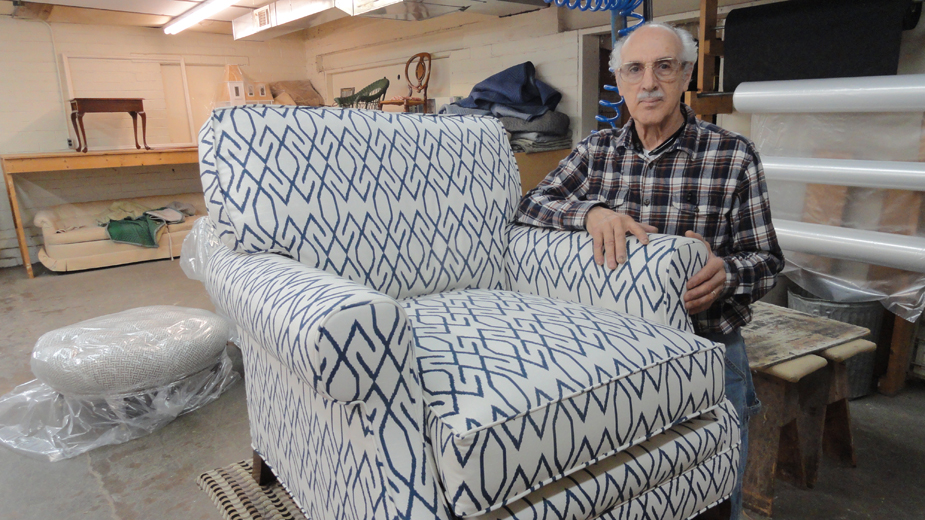Décor Trends Are in the Eye of the Beholder
YOUNGSTOWN, Ohio – Pieces of hard foam, fabric samples and large furniture staples litter the floor of R.A. Mayo Industries’ workshop in East Palestine. As one worker reupholsters a chair, another works on a loveseat, taking the furniture apart to attach new fabric.
Mayo Industries builds and upholsters furniture and, when a customer wants a change in style, reupholsters the same piece of furniture with a new fabric.
Mayo is one of six companies The Business Journal approached about trends in furniture and home décor. The others are Spruce Home Décor & Children’s Boutique in Niles, Meander Hill in Austintown, Rockwood Painting Contractors in Poland, Diane Coury Design Associates in New Castle, Pa., and Burke Décor in Boardman.
Since Bob Mayo opened Mayo Industries in 1961, he is yet to discern a trend in the styles of fabric his customers choose. The only trend he is certain of is that a customer will return to his shop every 10 to 15 years when he wants something new.
“The companies that create trends are the big furniture manufacturers. They make a piece of furniture and put it on a showroom floor. And the customer walks in and says, ‘I like that. I want to buy that.’ … So they’re buying a finished product,” he explains. “Here it is the opposite. A customer comes into my shop with an idea.”
Customers often arrive with pictures of how they want their furniture to look, which sometimes (but not always) follows the trends seen in department stores such as Macy’s or J.C. Penney. It depends on the customer.
“A trend to us isn’t really a trend. It’s what the individual thinks is a trend,” Mayo says.
Over the 56 years Mayo has been in business, he has never felt he was competing with furniture stores because he’s felt secure in his niche.
“People who are our customers can’t find what they want in a store, so that’s why they are our customers,” Mayo says.
Customers today are more attuned than ever to what’s chic in home decorating, experts say. Many homeowners receive their inspiration from reality TV shows and on cable channels such as HGTV. Three years ago, as he saw more and more people decide to reinvest in their houses and give them a new look, Nick Giancola opened Spruce Home Décor & Children’s Boutique in Niles.
One of the biggest trends in home décor, Giancola observes, is functional décor that can be easily updated, such as a vase filled with flowers in the spring that can be replaced with greenery in summer.
“People are looking for easily changeable décor items that they can set out and leave out and aren’t too much work,” he says.
Giancola, who’s also a home designer, gives his business a leg up by showing customers ideas on how to use accessories and furniture in their homes. He frequently restages items in his store to show customers, he says, that it’s about more than just buying an item. It’s about creating an experience and translating that experience in someone’s home.
“We can get creative and display products in a way [that others] can’t. It’s part of the experience as a designer that I can offer when customers come into my store,” he says.
Good experiences are what keep customers returning to Meander Hill in Austintown, says owner Evan Reese. The furniture and décor store was once a dairy barn, which in itself has drawn many visitors, many of whom don’t arrive planning to buy. Once they’re inside, though, they’re attracted to the Americana-style decorations.
“Customers have been in my store and admitted they tried to find items online similar to what I have,” Reese says. “But they usually can’t find them because they are one-of-a-kind. They do this to find the product at a cheaper price, but they can’t.”

Reese finds his products through artisans and wholesalers who make furniture and décor items by hand, which he says are now harder to find because so many went out of business as a result of competition from overseas.
When it comes to making a final decision on what decorations will help make a house more homey, it’s important to choose something that’s a mix of form and function, says Diane Coury Jacob, president of Diane Coury Design Associates.
“If you do something and it’s not functional, it’s not a good design,” she says.
Coury, an interior designer by profession, knows that every project she works on is a collaboration that involves the homeowner, designer, contractor and subcontractors.
For most projects, Coury consults not only with homeowners, but other designers, contractors and even subcontractors to create a final, unified design for a house.
She also works with several manufacturers to create custom products that range from chandeliers to window treatments to flooring. In her field, she says, it’s the manufacturers and interior design shows and events that keep her informed about styles and trends.
Many homeowners contact interior designers after their do-it-yourself strategies failed and the space they were working on didn’t meet the look or functionality they wanted, Coury continues.
So when Coury helps a client, she first listens to his needs, then turns the conversation to whether he called her at the onset of the project or when he realized he needed her help.
Some homeowners already know what they want to do, which Coury ascertains by asking why he wants a piece in a particular spot and how flexibles he is with where arrangements are placed.
Coury then reviews the client’s budget and expectations for the finished space.
“When you do this, you’re erasing question marks and giving everyone a roadmap,” she says.
In addition to the décor on the walls, the color of a room is a big concern for homeowners, says Dave Raspanti of Rockwood Painting Contractors. In a process of elimination – with the homeowner making the final decision – he asks how a room will be used, what the owner wants the room to look like and problems he might have encountered earlier.
For example, he explains, a reading room might have been painted too bright a color, while another might have been too dark, making it dreary.
Wallpaper goes in and out of popularity and of late is enjoying resurgence, says Erin Burke, owner of Burke Décor. Between her two stores – one in Boardman, the other in Los Angeles – and her website, BurkeDecor.com, her catalog offers more than 80,000 products, many with a modern look. Among the most popular is temporary wallpaper, which can be removed without damaging walls.
“Wall coverings have changed a lot since our parents and grandparents had them in their homes,” she says. Today the printing companies make the wallpaper and coverings look photographic and offer more expansive lines and selections.
Changes in trending styles haven’t affected Burke’s online catalog since she opened in 2007, she says, but business has greatly expanded with the help of internet searches and starting Burke Décor’s Trade Program, which gives design professionals help in quoting projects and offers discounted prices for each customized job.
Burke says that her business model is heavily dependent on how many eyes she can reach per search. If someone types in “dining room chair,” he could land on her page and become a customer. She hopes her business will keep expanding with the help of the internet and being more available to the homeowner.
“A traditional furnishing store’s model is having a showroom in a local region,” she says, “and our model is a little different because we reach people nationally on the internet.”
Pictured at top: Bob Mayo, owner of R.A. Mayo Industries.
Copyright 2024 The Business Journal, Youngstown, Ohio.



